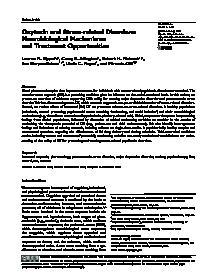Oxytocin and Stress-related Disorders : Neurobiological Mechanisms and Treatment Opportunities
Novel pharmacotherapies that improve outcomes for individuals with stress-related psychiatric disorders are needed. The
neurohormone oxytocin (OT) is a promising candidate given its influence on the social–emotional brain. In this review, we
present an overview of evidence supporting OT’s utility for treating major depressive disorder and posttraumatic stress
disorder.We first discuss endogenous OT, which research suggests is not yet a reliable biomarker of stress-related disorders.
Second, we review effects of intranasal (IN) OT on processes relevant to stress-related disorders in healthy populations
(anhedonia, reward processing, psychosocial stress reactivity, fear/anxiety, and social behavior) and their neurobiological
mechanisms (e.g., the salience network and hypothalamic–pituitary–adrenal axis). Third, we present the sparse but promising
findings from clinical populations, followed by discussion of critical moderating variables to consider in the service of
maximizing the therapeutic potential of OT (e.g., patient sex and child maltreatment). We also identify heterogeneous
findings and limitations of existing research, including reliance on single-dose studies in psychiatrically healthy samples and
unanswered questions regarding the effectiveness of IN drug delivery and dosing schedules. Well-controlled multidose
studies including women and measures of potentially moderating variables are sorely needed and would inform our understanding
of the utility of OT for preventing and treating stress-related psychiatric disorders.
In: Chronic Stress, ISSN 2470-5470 | 1 | 1–15
https://doi.org/10.1177/2470547016687996


